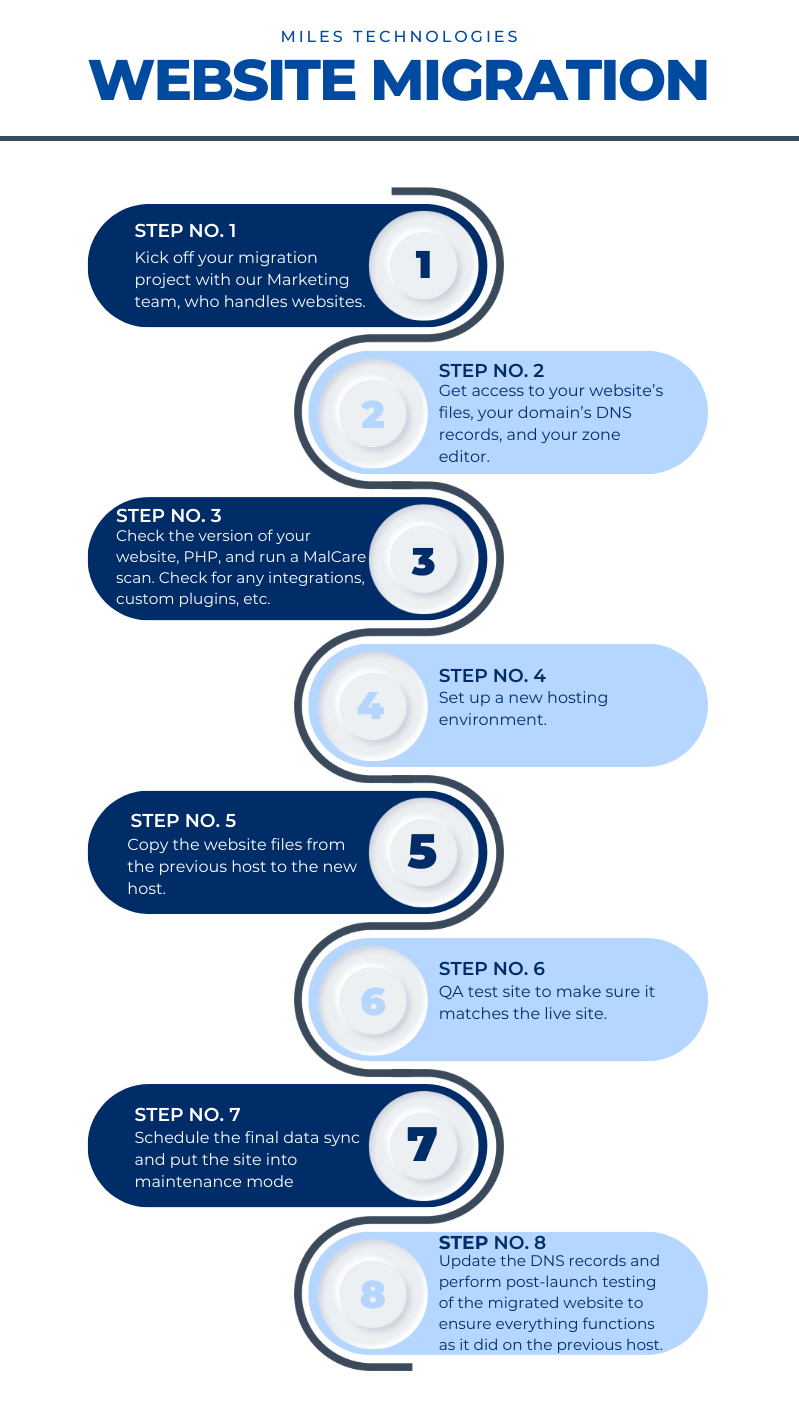In today’s digital age, having a functional and reliable website is essential for any business to establish an online presence and reach a wider audience.
A website serves as the primary point of contact between a business and its customers online.
With the increasing number of people relying on the internet to look for information, products, and services, it is critical to have a reliable website that is easy to navigate, informative, and visually appealing.
This article will explain everything you need to know when faced with the question of where to host your website and what you might need to understand about a possible website migration (and when you don’t even need one).
What Do You Need to Know About Website Migrations?
A website migration can be a complex process, and it’s essential to understand when to migrate your website and when another course of action is necessary.
One factor to consider when deciding whether or not to migrate a website is the amount of website traffic the business receives.
Suppose the website is experiencing high traffic levels that are causing slow load times or website downtime.
In that case, it may be time to consider migrating to a new hosting provider that can better handle the increased traffic.
It’s also important to consider the website’s content and functionality when deciding whether to migrate.
For example, an ecommerce site with an extensive product catalog may need a hosting provider that can handle high transaction volume and secure payment processing. If the current hosting provider is not equipped to address these needs, it may be necessary to migrate to a new provider that can.
Ultimately, the decision to migrate a website should be based on a careful assessment of the business’s current and future needs and consideration of the migration’s potential benefits and drawbacks.
What is Website Migration?
Website migration can be confusing for small business owners because it involves technical tasks that may not be familiar to them.
So, what is website migration?
Website migration refers to moving a website from one web host to another. It involves transferring website files, databases, and other relevant data to a new hosting provider, updating the domain registrar, and configuring the DNS settings.
Website migration can be complex and requires careful planning and execution to avoid potential issues. The reasons for website migration can vary, such as better pricing, improved features, or better support from a new hosting provider.
These factors can make website migration a daunting task for small business owners who don’t have the resources or level of expertise.
When Do I Need a Website Migration? (And When Do I Not?)
When building a new website or migrating an existing one, it’s essential to understand the terminology and distinguish between them.
While building a new website involves creating a website from scratch, a website migration involves moving an existing website to a new web host or platform.
To understand a migration, it is important to first know the three main pieces to your website: the files, the domain, and DNS.
Your website files are the pieces that make up your website and its corresponding data. The domain is the name of your website (for example, milesit.com), and DNS are the records that connect the two.
Here’s a breakdown of the key terms to help you differentiate between building a new website and migrating an existing one.

Do I Need to Migrate My Website for a New Company to Have Access to Everything They Need?
If you want to hire a new company to manage your website, you may wonder if you need to move your website to a new hosting provider. In most cases, a new company can be granted access to your existing website without needing a migration.
The answer really depends on the new company’s requirements.
If they need access to your website’s server, you may need to migrate to a more flexible hosting provider.
But if they only need access to your website’s CMS or other backend tools, you can grant them access without migration.
If you’re experiencing performance issues with your website, such as frequent server downtime or slow loading times, you may be wondering what the root cause of the problem is.
The answer may lie in your hosting provider, your website’s code, or a combination of the two.
If your website is hosted on a dedicated server or a reliable hosting provider and you’re still experiencing performance issues, the problem may be in your website’s code.
Your website’s code can impact performance, especially if it needs to be optimized for speed.
However, if your website is hosted on a shared server, the website’s performance can be impacted by the activities of other websites on the same server.
In this case, migrating to a dedicated server or a more reliable hosting provider can improve your website’s overall performance and reduce downtime.
If your website is currently hosted on a shared hosting environment controlled by a previous agency, and you’re considering moving to a new agency, you may need to migrate your website to a new hosting provider.
This is because the previous agency may have control over your website files, making it challenging for you to work with a new agency.
In this situation, migrating your website to a new hosting provider like Nexcess can give you complete control over your website files and make it easier for you to work with a new agency.
Situations Where You May Need a New Website Designed Instead of a Migration
Have you considered making changes to your website’s backend, such as installing a new CMS? If so, you may be wondering whether a website migration or a complete redesign is the best option.
In some cases, installing a new CMS on your website’s backend may require a complete redesign rather than a simple migration.
One example is when the new CMS requires a significantly different architecture or framework than your current website.
For example, suppose you’re currently using a custom-built CMS and want to switch to a more popular option like WordPress, Shopify, and Magento. You may need to redesign your website to accommodate the new CMS’s architecture and framework.
Additionally, if your website’s design needs to be updated or reflective of your brand’s current messaging or goals, a complete redesign may be necessary.
This can be an opportunity to refresh your website’s design, improve its user experience, and align it with your brand’s overall vision.
In these cases, it’s essential to work with a web development agency with experience in website migration and design to help you make the best decision for your website’s needs.
How to Choose a Hosting Provider
One of the biggest mistakes that website owners make is trusting obscure hosting companies. While these companies may offer lower prices or other incentives, they may not provide reliable services or customer support.
Choosing the right hosting provider is an important decision for any website owner; not all hosting companies are created equal. Selecting a reputable provider is essential to ensure your website runs smoothly and is accessible to visitors.
It may be tempting to choose a lesser-known provider because of their low prices, but this can be a dangerous decision.
How do you identify a good hosting company?
First and foremost, research is key. While many hosting vendors are out there, not all will be the right fit for your needs.
To ensure that you select the right hosting company for your website, it’s important to do your homework and gather as much information as possible.
One of the best ways to gauge a hosting provider’s quality is by reading customer reviews and testimonials.
By doing so, you can get an idea of the experiences that other website owners have had with that provider. Look for reviews that discuss uptime, page load speed, customer service, and security.
In addition to customer reviews, it’s important to research the hosting provider’s features, pricing, and terms of service.
Also, it’s always a good idea to check for uptime guarantees and service level agreements (SLAs) to ensure that the hosting company is committed to providing reliable service.
To ensure that your website has superior performance and accessibility, choosing a reputable hosting provider with a track record of providing quality services and reliable customer support is essential.
A reliable hosting provider should have measures to ensure maximum uptime, excellent security, and fast loading speeds.
Choosing a reputable hosting provider from the start is important, but remember that the second time can be the charm.
Sometimes, you may need to migrate your website to a new hosting provider because your current hosting company is going out of business.
In this instance, you would need to choose a new provider with solid financial history and a proven record of providing reliable service.
A provider with a history of frequent downtime or security breaches may not be a good fit for your website.
One of the most frustrating issues that website owners face is when a small web design firm creates their website and then holds it hostage.
This situation can occur when the website owner does not have access to their website files or hosting account, and the web design firm refuses to release them.
There are several reasons why a web design firm might hold a website hostage. For example, they may dispute with the website owner over payment for services rendered or be dissatisfied with the website owner’s decision to switch to a new provider.
To avoid this situation, ensure that you have an agreement with your web design firm that outlines who owns the website files and hosting account with allowed access to all of your website files and hosting account information.
In case your files are lost, we recommend that you always maintain backups of your website and information. We also suggest that you complete monthly backups (at a minimum) that are saved outside the hosting environment.
Our Approach for Website Migrations
At Miles IT, we pride ourselves on upholding high standards for all of our services, including website migrations.
We understand that website migration can be complex, with many potential pitfalls and challenges.
This is why our skilled teams have a dedicated “checklist” that ensures a successful and stress-free website migration.
Our team of experts has years of experience in website design and development and in website migration.
You can gain a general understanding of our process by reading the “checklist” below.

What’s Involved in a Maintenance Plan, and Why Do I Need a Company to Help Me with it?
A website maintenance plan is a crucial aspect of running a successful website. Regular maintenance ensures that your website remains up-to-date in terms of content and technology.
This helps keep your website relevant and engaging for visitors, which can lead to increased traffic and engagement.
A plan typically includes updating your website’s plugins and platform (WordPress & PHP), backing up your website, monitoring for security vulnerabilities, and fixing any issues.
With regular updates and security patches, you can protect your website from hacks and other cyber threats, which can be costly and damaging to your business.
A website maintenance plan also includes regular backups, which can be a lifesaver in the event of a website crash or other catastrophic event.
With backups, you can quickly restore your website to its previous state, minimizing downtime and lost data.
Security and Updating Plugins
In today’s digital age, website security is of utmost importance. Cyber threats such as malware, hacking, and data breaches can wreak havoc on your website and your business. That’s why ensuring the security of your website is a crucial aspect of a maintenance plan.
One of the benefits of working with a professional company is that they can help you monitor for security vulnerabilities and fix any issues that arise.
They may also provide services such as malware scanning and removal, firewalls, and SSL certificates to help keep your website secure.
Malware scanning and removal is essential for detecting and removing any malicious code that may have been injected into your website.
Finally, one of the most important tasks in a maintenance plan is updating your website’s plugins.
Plugins are software components that add specific features or functionality to your website. However, they can also pose security risks if not regularly updated.
An outdated plugin can provide a vulnerability that hackers can exploit to gain access to your website.
Regularly updating your plugins can help prevent security breaches and ensure that your website runs smoothly and securely.
Adding New Features and Functionality
As your business expands and evolves, your website may need to change to keep up with the changes.
Adding new features like pages, content, or functionality to your website is a great way to keep it up-to-date and provide more value to your users.
However, implementing these changes can be challenging, especially if you need more technical expertise to do it yourself.
This is where a professional web development company can help. They can work with you to identify the new features and functionality you want to add to your website.
Working with a professional company like Miles IT gives you peace of mind knowing that your website is in good hands.
We will take care of all of the technical details, leaving you free to focus on running your business.
Take a look at this example of a before-and-after feature created by our team using gravity forms on WordPress.

Moving Forward with Migration
Migrating your business website can be valuable if you’re looking for increased functionality, security, and scalability.
Make sure to take the time to determine whether a complete redesign, migration and/or maintenance plan is right for your business based on your needs.
Either way, ensure your website hosting provider is reliable so you can gain the level of customer support, security, and uptime that you need.
Start taking steps today to create a secure and impressive website that grows with your business and appeals to your audience.
If you have any questions about our approach to website migrations or security and maintenance plans, reach out to our marketing team at any time.
FAQ
If you’ve read this entire blog and still have questions, then you’re in luck! Here are some frequently asked questions.
Does Migrating Your Host Affect SEO?
A website migration doesn’t hurt your SEO unless it is done incorrectly. It can actually improve your SEO by fixing items that may have been wrong in the first place.
When completing a website migration, you’ll be spending time looking at your website, which may not have happened the first time through. This enables you to recognize more errors than you may have initally.
Plus, if another company created the site, you’ll be checking their work, which may have been poor. Or, you can identify better solutions, functionality, and more if the site is really old.
Search engines like Google use complex algorithms to determine the relevance and authority of websites, and any changes to your website’s hosting can potentially impact these factors.
Improper redirects, problems with robots.txt files, sitemap issues, and even broken internal links can inadvertently cause your site migration to drive a drop in organic search traffic.
Will My Website be Down During a Migration?
We generally update DNS early in the morning to allow time to propagate, so our team is available to perform post-launch testing.
If you’re conducting a website migration on your own or using another company, we highly recommend this approach, so you can catch any errors before your website visitors do.
During a DNS propagation, there isn’t downtime. It’s just a matter of which version of the website is viewed. DNS updates take a different amount of time, depending on the user’s internet connection and location.
However, if a resync is performed, a website is typically placed into maintenance mode to ensure that data (customer information or orders) is not added to your old host during the transition.
What information do you need to migrate my website?
When you are looking to migrate a website, there are 5 key things you need:
- Access to the current website: This includes the login credentials to the hosting account, domain registrar account, and CMS platform, such as WordPress.
- Domain name: The domain name is the web address that people use to access your website, and it needs to be transferred or pointed to the new hosting account
- Typically, your DNS host is your Domain Registrar, or who you pay to utilize your domain name. (DNS host and website host are typically not the same).
- Website files: This includes all the files that make up your website, such as HTML, CSS, JavaScript, images, and media files.
- Databases: If your website uses a CMS platform, such as WordPress, it will have a database that stores all your website’s content, such as pages, posts, and user data.
- Email accounts: If you have email accounts associated with your website domain, you will need to migrate them to the new hosting account.
It’s important to work with a professional website migration service provider like Miles IT, who can handle these details and ensure a smooth and successful migration process.


